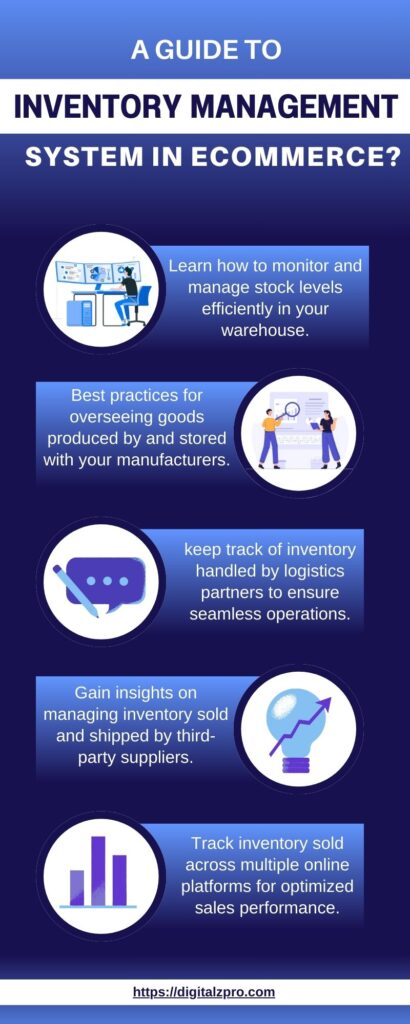In order for businesses to thrive in the online world, it’s crucial for them to expand their presence in the digital world. In an e-commerce business, managing inventory is of utmost importance. An inventory requires you to keep track of all the stocks in order for your e-commerce business to optimize its supply chain without overstocking its inventory or running out of stocks causing customer inconvenience.
Before getting started on the strategies let’s understand what inventory management is for e-commerce.
What is inventory management in e-commerce?
Inventory management is the process that involves controlling the order, storage, and use of products that are being bought online. If you look closely, you’ll see that inventory management and e-commerce inventory management are similar, the only difference is that, in e-commerce, the focus is completely on the products that are being sold online. With the rise of globalization, managing e-commerce inventory is essential as it will help you to:
- Track items within your warehouse
- Keep track of items managed through third-party logistics
- Managing inventory stored with contract manufacturers or consigned with another business
- Overseeing products sold via dropshipping
- Monitoring your multichannel selling strategies

By optimizing inventory management, it can help you better understand your logistics and analytics. This information will help you to maintain ideal stock levels, helping you to make better predictions on inventory demand.
Now that you know what inventory management is let’s look at some of the benefits that good inventory management provides us with:
Benefits of Good Inventory Management:
Poor inventory management can cause various disruptions within your business. The failure to deliver the products to your customers at the right time may cause damage to your business’s reputation, driving customers away.
With that being said, here are some of the benefits of improving your e-commerce inventory management.
1. Improved Customer Relations:
Customer relations are an important part of a successful business. Establishing customer loyalty allows businesses to gain more value over time compared to acquiring new customers. By getting your inventory fully optimized you can easily avoid delays and long lead times and improve customer satisfaction for your business.
2. Overseeing Inventory:
Keeping control over the inventory allows you to manage your inventory efficiently and restock the items at the right time. By optimizing inventory management you can effectively handle various inventory types such as raw materials, finished goods inventory, third-party store inventory, etc. Segregating your inventory will allow you to function in an optimal manner and take control of the inventory allowing you to manage stock in a better manner.
3. Improving Efficiency:
For e-commerce businesses, their inventory is of pivotal importance, since it not only influences your day-to-day functioning but also the long-term sustainability of your business. You can also unlock essential insights by mastering the movement of goods within your business and throughout the supply chain. These insights allow you to improve your business in various ways such as:
➢ Streamlining Supply chain:
In an e-commerce business, getting the goods delivered in an effective manner is of crucial importance. By maintaining a good rapport with your suppliers you can ensure a smooth delivery of the goods to your customers.
➢ Demand Estimates:
By measuring and keeping track of the demand for goods that you keep in your warehouse, you can maintain optimal stock levels and avoid running out of stock or overstocking. This will help you save a lot of hassle, labor, and finances.
➢ Inventory Control:
Make use of the lean inventory practice where warehouses only keep stock of the products that are fast-selling. This helps you to reduce costs while ensuring that the products in demand are in stock. You can also use inventory management techniques, such as ABC (Always Better Control) analysis, just-in-time (JIT), or drop shipping, to prioritize, replenish, or outsource your inventory according to its value, turnover, or availability.
➢ Inventory Processing and Shipping:
By efficiently processing the orders and enhancing the delivery systems you can improve your customer satisfaction levels. A lot of customers expect quick, smooth, and hassle-free deliveries, and in order to achieve that for your business it’s essential that the inventory processing is smooth and accurate stock levels are maintained. This helps in reducing errors and improves overall customer satisfaction.
Now that we know the benefits of good inventory management let’s have a look at the strategies required for optimal efficiency in inventory management.

Strategies for Optimal Inventory Management:
1. Safety Stock:
You can stock up on the unperishable products that are in demand in your warehouse so that when there is a sudden surge in demand for the product you have the stock and can safely fulfill your customers’ orders while not harming your inventory levels. Safety stock refers to the stock besides your daily demands. In order to calculate how much safety stock your business should have, you can make use of the following formula:
Safety stock = (Max daily usage x max lead time in days) – (average daily usage x average lead time in days)
2. Inventory Kitting:
You start noticing that a lot of the products are not as much in demand as they were before and you have a lot of them. But it comes to a point where you might have to consider cutting your losses. That doesn’t necessarily mean you should throw everything out the window. One technique you can implement is kitting your products. This is where you bundle your slow-moving or dead stock with an item that is selling well so you can offload the products and recover some of your costs.
3. Market Demand Analysis:
To optimize and efficiently handle your inventory, this is a crucial step for a spring clean. The purpose of performing demand planning is to make future sales and stock level requirements a little less uncertain. In order to do this, look into historical sales data and identify past trends to predict what you’ll need for the coming period. You can make use of the PEST analysis to make these estimations by considering the following factors:
- Political
- Economical
- Sociocultural
- Technological
4. Implementing the ABC Inventory Model:
This technique allows you to better manage your high-value inventory. It allows managers to use their resources efficiently. The system divides the company’s inventory into categories where, category A items are the most important, followed by category B and then category C which consists of items that are least important. The ABC tool greatly helps businesses improve their inventory management and allows the business to keep their most important products in stock always.
5. Storage and Routing:
In terms of e-commerce, storage, and routing refers to the process where the products are stored and the path taken from storage to the customer. A few of the key strategies include:
- Improved Warehouse Layout:
Arrange items based on the kind of demand that they have. Arrange the products according to high-to-low demand for easy access and a streamlined picking-up process.
- Inventory Classification:
Categorize the inventory in the most efficient way for storage and easy handling. Group similar products together for optimal storage and start by classifying them on factors such as frequency of demand, value, etc. By structuring your inventory strategically, you can enhance productivity, minimize handling errors, and improve overall workflow efficiency.
- Implementing Technology:
Make use of WMS (Warehouse Management System), in order to enhance the efficiency of handling warehouse management. A WMS provides real-time visibility into inventory levels, enabling better tracking and control of stock. It helps automate key processes such as order picking, packing, and shipping, reducing manual labor and errors. With advanced analytics and reporting features, a WMS helps optimize space utilization, streamline orders, and improve order accuracy. By integrating WMS into your operations, you can boost productivity, reduce operational costs, and ensure a more organized and responsive warehouse environment.
- Stocktakes:
While conducting stocktakes, you compare your physical stock with the records to identify any discrepancies that might be there. This helps you to figure out the areas that need your attention and improvement in management practices. By addressing these issues you can improve your overall inventory management system and keep your inventory up to date. It also allows you to identify any damaged or expired products, which will allow you to decide whether to keep stocking the products or not, in order to avoid unwanted products taking up space in your inventory.
Conclusion:
To conclude, mastering e-commerce inventory management is essential for achieving optimal efficiency and profitability. By implementing effective strategies such as accurate demand forecasting, strategic inventory segmentation, and utilizing advanced technologies like a Warehouse Management System (WMS), businesses can streamline their operations and reduce costs. Efficient inventory management not only ensures that stock levels meet customer demand but also minimizes the risks of overstocking and stockouts. Ultimately, these practices lead to improved customer satisfaction, higher sales, and a stronger bottom line. By continuously refining and adapting these strategies, e-commerce businesses can maintain a competitive edge and drive long-term success.

Disclaimer: Disclaimer: The views and opinions expressed in this article are those of the author and do not necessarily reflect the official policy or position of Digitalz Pro Media & Technologies.
Author: Joseph George is an SEO Content Researcher. He enjoys writing about his experiences and especially likes to write about staying healthy. Joseph loves exercising and keeping his body fit. He also enjoys reading books and blogs on different topics. Besides health, he writes about real estate, vertical farming, e-commerce marketing, digital marketing, and more.





